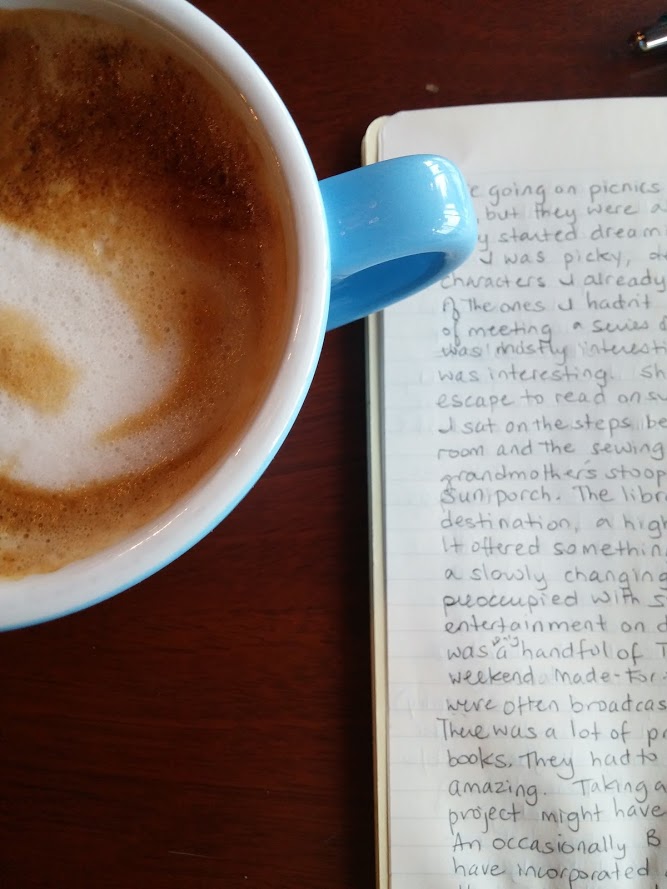Straight up, I’m a sucker for illustrated books like this. But I’ve also been disappointed on occasion, having found the accompanying narrative lacking. So when I picked up Storyville, I was cautiously enthusiastic: would the graphic content be forced to carry the bulk of the load? No need to worry: the balance is wholly satisfying.
The graphic style is somewhere between clip-arty and doodle-y, but not in the sense that anyone purchased a set of a thousand images and now has to fit them all into this book. Only at first glance do the images seem generic—they align neatly with the content. (There’s a beach umbrella with this Eugène Ionesco quotation, for instance: “A writer never has a vacation. For a writer, life consists of either writing or thinking about writing.”)
Full-page quotations, white text on a black background (with the white beach umbrella!) salt and pepper the book. For avid readers of books about writing, some of these will be familiar, but many of them are fresh, and drawn from a variety of genres and decades. They’re also positioned within the relevant chapters, integrated into the text, which gradually establishes into an air of authority.
The text is divided into four parts: The Fiction Writer, The Fiction Writing, The Plot, and The Revision. (Illustrated in the TOC with a pair of scissors cutting along a dotted line, with four letters floating above the paper—an E and a W, a J and a D, the illustrator’s and author’s initials—as if to prove that these simple images are carefully curated.) I appreciate the effort to keep it simple. When you get to this chapter, another set of TOCs follows the title page, which suggests that the book is designed to pull readers straight through and discourage dabblers.
Within “The Fiction Writing”, for instance, one of the segments is illustrated by a magician’s hat upended, with a rabbit peering out (one ear up, one ear down): “Surprise the Reader”. I appreciate the approach of surprise being something that the writer experiences too—”what brings us to the desk every day”—as well as more concrete advice from a craft perspective: “A surprise might be a robust verb, an unpredictable behavior by a character, an abrupt shift in time or place, a plot point that spins the action of the story off in a new directions, or an unexpected turn of events.”
Speaking of a pleasant surprise, I really appreciate the renaming of “writer’s block” as a natural step in the creative process (renamed “gestation”). Dufresne is not the first to take this approach, but he states it so confidently that it seems he could have been. Another happy surprise? Finding a page of dialogue from The Golden Girls on the theme of “writer’s block”! (Dorothy gets the biggest laugh, of course.) He’s also not the first to granularly break down the revision process (into rewriting, line editing, copy editing, and proofreading) but his suggestions are spot-on. This advice will be most helpful to emerging writers, but I appreciate the reminder that editing (like procrastinating, like gestating) is an essential part of the process.
There are two graphics which stand out for me. First, the “Story as Iceberg” page, which illustrates “The What?” as the 10% which shows above the surface of the water, with “The Why” lurking in the larger chunk of ice beneath, with “Lies, Secret, Family, Values, Beliefs, Culture, Dreams, Phobias, Heritage, Thoughts, Emotions, Motivation, Experience, Aspriations, and Childhood Traumas” lurking. And, furthermore, the last graphic, which I won’t spoil, because it simultaneously seemed both a basic and brilliant ending.
Really Good Stuff for Writers.
John Dufresne. Storyville: An Illustrated Guide to Writing Fiction. Illus. Evan Wondolowski. New York: W. W. Norton & Company, 2020.

